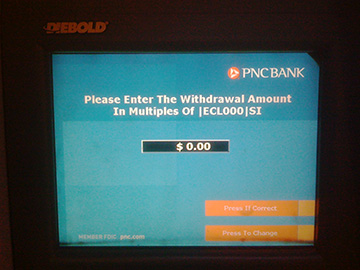
 If ordinary bank ATMs can be made secure and reliable, why can't electronic voting machines? It's a simple enough question, but, sadly, the answer isn't so simple. Secure voting is a much more complex technical problem than electronic banking, not least because a democratic election's dual requirements for ballot secrecy and transparent auditability are often in tension with one another in the computerized environment. Making ATMs robust and resistant to thieves is easy by comparison.
If ordinary bank ATMs can be made secure and reliable, why can't electronic voting machines? It's a simple enough question, but, sadly, the answer isn't so simple. Secure voting is a much more complex technical problem than electronic banking, not least because a democratic election's dual requirements for ballot secrecy and transparent auditability are often in tension with one another in the computerized environment. Making ATMs robust and resistant to thieves is easy by comparison.
But even ATMs aren't immune from obscure and mysterious failures. I was reminded of this earlier today when I tried to make a withdrawal at a PNC Bank cash machine in Philadelphia. When I reached the screen for selecting the amount of cash I wanted, I was prompted to "Please Enter The Withdrawal Amount In Multiples of |ECL000|SI". Normally, the increment is $10 or $20, and |ECL000|SI isn't a currency denomination with which I'm at all familiar. See the photo at right.
Obviously, something was wrong with the machine -- its hardware, its software or its configuration -- and on realizing this I faced a dilemma. What else was wrong with it? Do I forge ahead and ask for my cash, trusting that my account won't be completely emptied in the process? Or do I attempt to cancel the transaction and hope that I get my card back so I could try my luck elsewhere? Complicating matters was the looming 3-day weekend, not to mention the fact that I was about to leave for a trip out of the country. If my card got eaten, I'd end up without any simple way to get cash when I got to my destination. Wisely or not, I decided to hold my breath and continue on, hoping that this was merely an isolated glitch in the user interface, limited to that one field.
Or not. I let out an audible sigh of relief when the machine dispensed my cash and returned my card. But it also gave me (and debited my account) $10 more than I requested. And although I selected "yes" when asked if I wanted a receipt, it didn't print one. So there were at least three things wrong with this ATM (the adjacent machine seemed to be working normally, so it wasn't a systemwide problem). Since there was an open bank branch next door, I decided to report the problem.
The assistant branch manager confidently informed me that the ATMs have been working fine, that there was no physical damage to it, and so I must have made a mistake. No, there was no need to investigate further; no one has complained before, and if I hadn't lost any money, what was I worried about? When I tried to show her the screen shot on my phone, she ended the conversation by pointing out that for security reasons, photography is not permitted in the bank (even though the ATM in question wasn't in the branch itself). It was like talking to a polite brick wall.
Such exchanges are maddeningly familiar in the security world, even when the stakes are far higher than they were here. Once invested in a complex technology, there's a natural tendency to defend it even when confronted with persuasive evidence that it isn't working properly. Banking systems can and do fail, but because the failures are relatively rare, we pretend that they never happen at all; see the excellent new edition of Ross Anderson's Security Engineering text for a litany of dismaying examples.
But knowing that doesn't make it any less frustrating when flaws are discovered and then ignored, whether in an ATM or a voting machine. Perhaps the bank manager could join me for a little game of Security Excuse Bingo [link].
Click the photo above for its Flickr page.
N.B.: Yes, the terminal in question was made by Diebold, and yes, their subsidiary, Premier Election Systems, has faced criticism for problems and vulnerabilities in its voting products. But that's not an entirely fair brush with which to paint this problem, since without knowing the details, it could just as easily have been caused entirely by the bank's software or configuration.